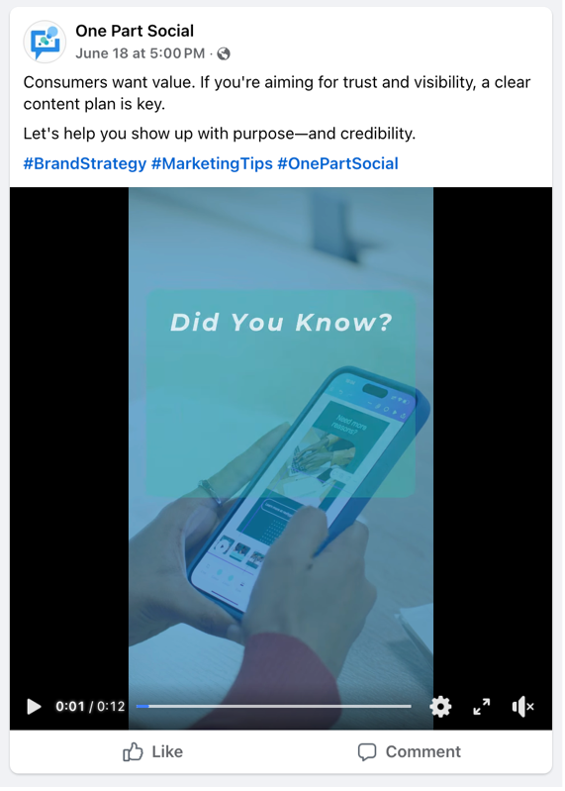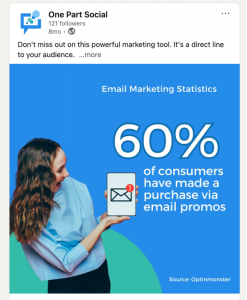Suffering from content burnout? You may be a candidate for content repurposing.
Hear us out…
You’ve poured your heart into that blog post, podcast, or newsletter. You researched, revised, and hit “publish.” Maybe even celebrated with a mocha latte or iced coffee—we, at One Part Social, can attest to this.
But then what? Crickets. No likes, spikes, or bites to speak of.
What’s worse, caffeination quickly turns to rumination when planning next week’s promotional calendar. Another blank page staring back at you… do you know what’s happening?
That’s content burnout—a churn and burn that most marketers and business owners inevitably experience.
It’s easy to see how we got here. Millions of posts hit social media every day. Experts, for instance, recommend posting daily on LinkedIn and Facebook. And a minimum of three to five times a week on Instagram. That pace is daunting even for #TrueBlue marketers like us.
So, What is Content Repurposing? It’s Recycling and Repackaging Your Most Evergreen, Top-Performing Campaigns for Another Go-Around.
Content repurposing helps businesses stay visible, consistent, and efficient. By tickling the archives, you needn’t post from scratch. Instead, businesses treat their digital footprint like a cyclical feed—what’s old can be new again.
Meanwhile, back-end KPIs (Key Performance Indicators) are the workhorse, indicating where to pony up and double down on previous posts. More on that later…
Bottom line: content repurposing extends one’s reach. The right refresh or reframe—and the right delivery method—puts engagement on repeat. From short soundbites (e.g. video reels) to long formats (e.g. case studies), get more mileage from your message.
The Real Value of Content Repurposing: 4 Time-Saving Content Tips
At its core, content repurposing means reworking existing material into different formats for deployment across different platforms. It’s NOT reposting the same thing everywhere. It IS reshaping your message to meet new audiences where they’re at.
So, why does that matter?
Content repurposing saves serious time.
A strong blog post could inspire multiple touchpoints via an email, caption, or podcast segment. By piecemealing key information, you avoid creating these assets from ground zero. In fact, businesses typically get more ROI from content they’ve already invested in.
Content repurposing helps reach more people.
Your audience doesn’t all hang out in one place. Someone might miss your blog, but catch the recap on Instagram. Or skip your webinar, but find your breakdown on LinkedIn. This strategy predisposes a diverse audience to your message.
Content repurposing boosts online searchability.
Search engines recognize when websites consistently cover a subject. More optimization means higher rankings as indexed across results pages (a.k.a. Google). Repurposing also lets you study the algorithm and target a mix of related keywords. Drive traffic using broad terms in one format and/or long-tail phrases in another.
Designated offshoots like blogs, videos, and infographics increase your chances of being discovered, linked to, and shared by others.
Content repurposing keeps messaging consistent.
People need to see or hear your message (what used to be at least seven times) is now sometimes more than 12 times before taking action. Repurposing “sticky content” helps reinforce your voice, values, and vision across multiple channels. In turn, you stay top-of-mind, on-brand, and far from repetitive.
What to Repurpose First (And Why It Matters)
Let’s be real: not all content deserves a remix. So, what should be cut?
Step 1: Choose content-rich formats.
Select material that gives more elasticity and relevance. Look for meat on the bones—blog posts, podcasts, and webinars are packed with hefty ideas. This makes it easy to slice and dice into smaller pieces.
Think quotes, stats, highlights, or summaries. If it’s valuable to your audience, then it’s worth repeating.
Step 2: Check what’s already working.
Before repurposing anything, check your analytics (KPIs). What’s getting the most traffic, shares, or saves? Start there. Then match your content to your current goal.
- Want more brand awareness? Examine what sparked the most shares.
- Aiming for engagement? Find what pulled in the most comments.
- Need steady traffic? Re-launch promos that attract clicks.
High-performing content has already done the hard part: connecting to your audience. It’s your job to maintain its utility.
Step 3: Remix content that never expires.
Evergreen content remains useful, standing on its own regardless of trends and news cycles. It’s a cash cow that needs little foraging, so “milk it” for all it’s worth. Try converting evergreen information into how-to posts, tutorials, FAQs, and big-picture insights.
Also, look inside your organization. What content does your team share? That one-pager clients love? A sales deck that ushers downloads? An annual report chock full of achievements?
If it’s useful internally, chances are it has external value too.
Step 4: Give older campaigns a second life.
Running low on ideas? Time to dig into the archives. Look for resources that still get traffic but might be a little dated. A piece from 2020 that’s still ranking? That’s a win waiting to happen.
But bear in mind current social and cultural norms. Update stats, swap outdated examples, and tighten the copy if needed.
Then break it down:
→ Parcel into an email series.
→ Pull a quote for a social post.
→ Create a short video recap or teaser.
→ Skew it toward a new audience or platform.
Repurposing gives old content a new look (and a longer shelf life).
Step 5: Make content repurposing part of your workflow.
Don’t treat time-saving content tips as a one-off. Build it into your process from the start.
Planning your content calendar? Aim to repurpose at least one piece each week.
Publishing a podcast? Try this simple workflow:
- Pull a standout quote for socials
- Transcribe key takeaways for a blog post
- Clip 2–3 moments for a short-form video
- Recap the episode in your newsletter
Repeatable workflows save time and increase impact. The more you do it, the easier it becomes.
4 Secrets to Reimagine Bingeworthy Content… Like A Pro
One core piece of content can go a long way. Here are four simple tricks to make it work harder.
Make It Swipeable (Turn content into a carousel)
Carousels break big ideas into bite-sized slides your audience can digest on-the-go.
Start with a blog post, webinar, or long-form report. Pull out the best quotes, stats, or takeaways. Add visuals to guide the scroll—Canva or AI programs can help in a pinch.
Carousels are swipe-friendly snippets and great for platforms like LinkedIn and Instagram. It’s snack-sized storytelling that’s food for thought.
Make It Watchable (Pull clips for a short-form Reel)
Long-form content is great for depth, but not everyone has time to read or watch. That’s where Stories and Reels come in. Here is how to make a quick synopsis:
- Pick one clear message—don’t try to cover everything in your blog, podcast, or webinar
- Keep it short—15 to 60 seconds is the sweet spot
- Add captions so it’s watchable without sound
- Use brand colors and fonts to keep it stylized
- Not camera-ready? Use text overlays, B-roll, or a voiceover instead
Make It Shareable (Turn a quote or stat into a graphic)
Some headlines are too good to stay buried in an article or webinar transcript.
Pull a powerful quote from a speaker, customer, or post and turn it into a branded graphic. Statistics or figures work well too, especially if they support your authority or industry insight. Use them to spark conversation or highlight your expertise.
Example: Imagine a podcast episode where your guest says, “Most small businesses waste 30% of their content potential.” That’s your next LinkedIn post. Just add a bold graphic, a cheeky-yet-confident font, and a question to spark replies.
P.S. Don’t forget to credit your source as shown below!
Make It Clickable (Write an email newsletter)
Not everyone catches your content on social media. A good recap delivered straight to a customer’s inbox is key.
Start with a quick hook or takeaway. Something punchy that grabs attention.
Then:
- Summarize the core message in a few lines
- Pull in one quote, stat, or insight to add value
- Link to the full piece (sending folks to your blog, webinar, or podcast)
- Add a strong call to action so readers know what to do next
Email helps you stay visible with the people most likely to engage.
Want to see it in action? 📩 Join our mailing list.
Helpful Tools for Content Repurposing
The right tools = faster repurposing, stronger content, and way less stress. Here are a few MVPs worth knowing.
🎨 Design It
Turn words into visuals that get shared.
- Canva: Great for carousels, graphics, and on-brand templates
- Napkin AI: Transforms complex concepts into diagrams and infographics
- GoogleFX: Perfect for turning ideas into original images
🎥 Clip It
Video doesn’t have to be complicated.
- Descript: Edit audio or video just by editing the transcript
- CapCut: Add captions, trim clips, and style short Reels in minutes
- Lumen5: Turns blog posts into lightweight videos with AI
📝 Write It
From blog to caption, these tools do the heavy lifting.
- ChatGPT: Rework content into emails, posts, or summaries
- Jasper: Devise copy drafts with tone and brand presets
- Grammarly: Proofread content for clarity and typos
Hint: AI is pulling its weight in nearly all these categories. Want more AI marketing strategies? We’ve got you covered. 🔗
Final Reminders Before You Lather, Rinse, and Repeat
Before you hit “post” (again), keep these time-saving content tips in mind:
✔️ One format doesn’t fit all
Each channel has its own rhythm. A Reel, a LinkedIn post, and a newsletter should all feel different, even if the message is the same. Adjust tone, length, and layout to fit where it’s going.
✔️ Keep it fresh
Old stat? New example. Don’t just copy-paste content when you repurpose. Every piece should feel relevant right now. Recalibrate visuals, headlines, or phrasing to fit the moment.
✔️ Don’t skip the CTA
Every piece of marketing needs a next step. Whether it’s to read, to watch, or to subscribe, give your audience somewhere to go.
Feeling inspired—and maybe a little overwhelmed? That’s exactly why we wrote this definitive guide.
Content repurposing isn’t about doing more. It’s about doing better with what you’ve already created. Now you’ve got time-saving content tips, tools to try, and a repeatable system to stay visible with less stress.
I’ve helped brands turn one strong idea into weeks (and months!) of high-performing content. Care to know more?
Book a free 30-minute call with me (Melissa here 👋), and we’ll map out how to make your content work harder—for real results.
Let’s build a content system that finally works for you. Ready, set, repeat.


